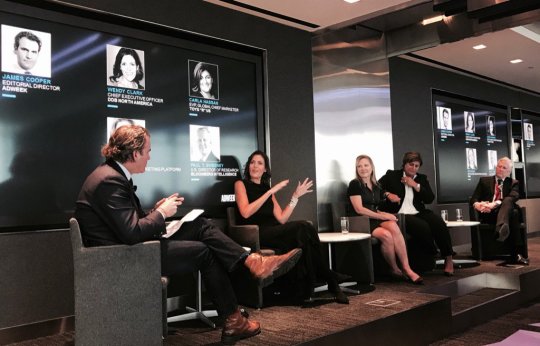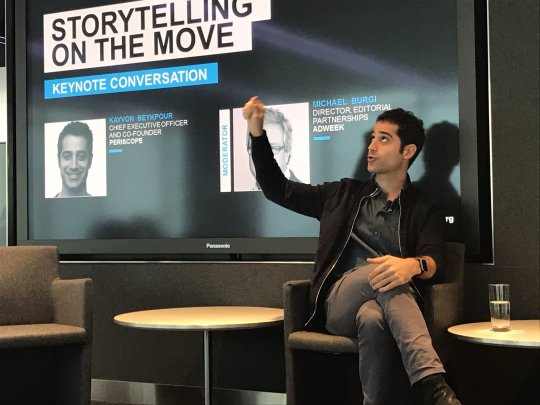March 30, 2017
As mobile technology changes the way people live and work, it’s also creating new imperatives for business. The next disruptor is always right around the corner.
That’s why the convergence of mobility and content is a huge focus for the marketers helping define new business strategies in response. Get the technical and creative challenges right, and mobile can be a powerful business driver. Get it wrong, and it’s not just a neutral for the business – it’s actively negative.

Attendees gather at Bloomberg’s New York headquarters for the first event in an ongoing series hosted by Adweek and Bloomberg Media.
That new reality was the subject of the first in an ongoing breakfast event series convened by Adweek and Bloomberg Media to examine the future of marketing in an interruptive world. Adweek Editorial Director James Cooper and Bloomberg Media CRO Keith A. Grossman welcomed brand and agency guests to Bloomberg’s New York headquarters this week for an event that covered everything from the economics of mobile to storytelling on the go.
Bloomberg Intelligence U.S. Director of Research Paul Sweeney kicked off the session with a briefing on the state of mobile – with a view to the bottom line.

Bloomberg Intelligence U.S. Director of Research Paul Sweeney briefs the audience on the state of mobile.
Although ad growth has roughly tracked GDP, Sweeney explained, the biggest trend over the past four or five years has been mobile. To illustrate its importance to companies, he offered a key example: Facebook. When the company went public several years ago, about 35% of its users were mobile – but virtually no revenue generated from them. Today, 85% of its usage, and 82% of its revenue, come from mobile.
The significance of Facebook’s successful pivot from desktop to mobile can’t be overstated. “If you don’t have a mobile strategy, you’re nowhere,” said Sweeney.
That idea was amplified by the conversations that followed. The event included both a panel, featuring marketing gurus Wendy Clark, CEO, DDB North America; Kim Kadlec, SVP, Global Marketing Platform, Visa; and Carla Hassan, EVP, Global Chief Marketing Officer, Toys” R”Us; and a one-on-one chat with Periscope CEO Kayvon Beykpour.
Read Adweek’s coverage of the event: How Visa and Toys R Us Are Embracing a Mobile-First Future

Panelists share insights with Adweek Editorial Director James Cooper. L-R: Cooper; Wendy Clark, CEO, DDB North America; Kim Kadlec, SVP, Global Marketing Platform, Visa; Carla Hassan, EVP, Global CMO, Toys”R”Us; Paul Sweeney, U.S. Director of Research, Bloomberg Intelligence
The panelists agreed that mobile is now more a concept than a piece of equipment. “It’s the way people are living their lives now that we need to lock on to, rather than any screen,” said Clark. In her previous role as a top marketing exec for Coca-Cola, she added, there was a shift in focus from point-of-sale to “the point of the moment of desire – and mobile is the medium that allows you to do that.”
“Marketers are more on the hook to understand data and technology,” Kadlec said. “Just pushing the button and getting it out there isn’t enough – it’s about consumer behavior. The expectation from consumers is that data be used to add value: to create magic, to make something useful, to make it fun.”
It also means throwing out the legacy playbook. Kadlec recommended “fearless collaboration” across technology, product and marketing teams; Hassan said “brands need to be honest with themselves,” because “it’s not a build-it-and-they-will-come world.”
And as Adweek reported, Visa, Toys”R”Us and the brands DDB North America serves are all actively exploring how technologies like voice-activated digital assistants, wearables, and internet-connected cars can be used to help improve consumer experiences and drive brand preference.

Periscope CEO Kayvon Beykpour talks with Adweek Director of Editorial Partnerships Michael Burgi
That breadth of thought was also evident from Periscope CEO Beykpour, who said the company views itself “not just as an app, but a medium – a platform for people to have a conversation with each other.” Founded as one of the first live video streaming apps, Periscope was acquired by Twitter in 2015. Twitter announced on the morning of the event that it is adding advertising to Periscope posts, with an eye to predictability.
The company’s business model, Beykpour said, is focused not only on safety but around giving brands “the most creative levers possible.” That means streaming not just content mobile phone cameras but also from GoPro, drones, and even VR devices. “Your creative canvas becomes much more powerful if it’s not just your phone that’s connected,” he said.
Big thinking that incorporates creativity as well as data and technology may be more needed than ever, as concerns about quality, transparency and privacy emerge in digital advertising. That, in turn, affirms the key role of marketing within the business landscape, as the mobile lifestyle continues to evolve at breakneck pace.
Read more:
Adweek: Mobile Channel
Bloomberg: Twitter Adds Video Advertising to Periscope
– Jen Robinson | March 30, 2017